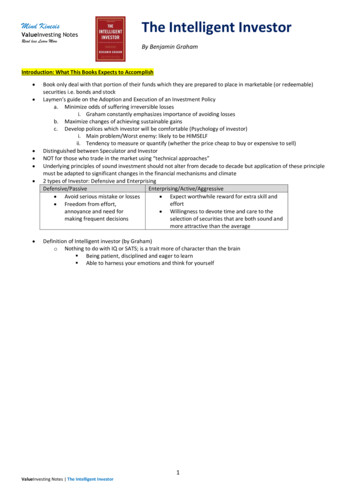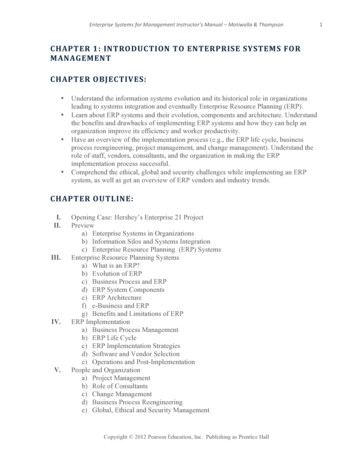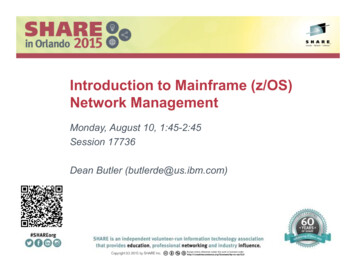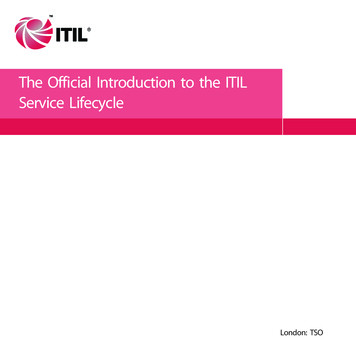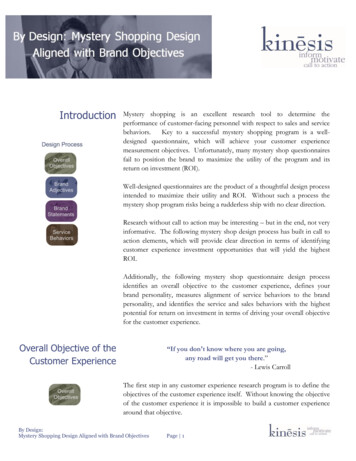
Transcription
IntroductionMystery shopping is an excellent research tool to determine theperformance of customer-facing personnel with respect to sales and servicebehaviors.Key to a successful mystery shopping program is a welldesigned questionnaire, which will achieve your customer experiencemeasurement objectives. Unfortunately, many mystery shop questionnairesfail to position the brand to maximize the utility of the program and itsreturn on investment (ROI).Well-designed questionnaires are the product of a thoughtful design processintended to maximize their utility and ROI. Without such a process themystery shop program risks being a rudderless ship with no clear direction.Research without call to action may be interesting – but in the end, not veryinformative. The following mystery shop design process has built in call toaction elements, which will provide clear direction in terms of identifyingcustomer experience investment opportunities that will yield the highestROI.Additionally, the following mystery shop questionnaire design processidentifies an overall objective to the customer experience, defines yourbrand personality, measures alignment of service behaviors to the brandpersonality, and identifies the service and sales behaviors with the highestpotential for return on investment in terms of driving your overall objectivefor the customer experience.Overall Objective of theCustomer Experience“If you don't know where you are going,any road will get you there.”- Lewis CarrollThe first step in any customer experience research program is to define theobjectives of the customer experience itself. Without knowing the objectiveof the customer experience it is impossible to build a customer experiencearound that objective.By Design:Mystery Shopping Design Aligned with Brand ObjectivesPage 1
Consider the following proposition:“Every time a customer interacts with a brand, thecustomer learns something about the brand, andbased on what they learn, adjust their behavior ineither profitable or unprofitable ways.”PositiveBuy MoreNegativeBuy LessComplain LessComplain MorePositive Word ofMouthNegative Wordof MouthLess ExpensiveChannelsExpensiveChannelsLoyaltyLess LoyalThese behavioral changes could be positive or negative. For example,customers may buy more, complain less, give positive word of mouth, useless expensive delivery channels, or be loyal customers; or they maypurchase less, complain more, spread negative word of mouth, useexpensive delivery channels, or be less loyal.This proposition is powerful. It is the key to managing the customerexperience in way that will achieve your overall customer experienceobjectives. It is the key to a profitable customer experience. It givescustomer experience managers a clear objective, defining what you want thecustomer to learn from, and react to, the customer experience. Ultimately,this proposition serves as a guidepost for every aspect of managing thecustomer experience – including customer experience measurement.Defining the overall objective of the customer experience is a fairly simpleprocess. Again, considering the above proposition that customers learn andadjust behavior in profitable or unprofitable ways as a result of the customerexperience, ask yourself: What is the overall objective of the customer experience?How do you want the customer to feel as a result of the experience?How do you want the customer to act as a result of the experience?For example: Do you want the customer to have increased purchase intent?Do you want the customer to have increased return intent?Do you want the customer to have increased loyalty?The answers to the above questions will serve as guideposts to designing thecustomer experience, designing an experience which will achieve yourcustomer experience objectives. Again, if you don't know where you aregoing, any road will get you there.By Design:Mystery Shopping Design Aligned with Brand ObjectivesPage 2
They serve as the basis for evaluating every aspect of the customerexperience – aligning training, monitoring, incentives and rewards in acoordinated effort to achieve your overall objective.We call this Key Driver Analysis,an analytical technique to identifywhich behaviors are key drivers ofyour overall customer experienceobjective.In terms of monitoring the customer experience, the answer to thesequestions will become the dependent variable in analyzing your customerexperience research. Or to put it another way, the variable that is influencedby the specific service attributes of the customer experience. Kinēsisendeavors to understand the relationship of these service attributes to theoverall customer experience objective. We call this Key Driver Analysis, ananalytical technique to identify which behaviors are key drivers of youroverall customer experience objective.An Example:To illustrate this, consider the following example: Assume you define theoverall objective of the customer experience is increased purchase intent.As part of a mystery shop program to measure and motivate sales andservice behaviors, include a question to capture purchase intent a questionlike, “Had this been an actual visit, how did the experience during this shopinfluence your intention to initiate or maintain a relationship with thebrand?” This is the dependent variable – the variable used to compare themystery shop behaviors and attributes to determine the strength of theirrelationship to purchase intent.Definition of BrandPersonalityBrands have personality. Brand personality is how the brand is perceived- a set of characteristics which define the positioning, products, price andthe mix of service attributes offered by the brand.Ask yourself, how would we describe our brand?I’m frequently surprised how often new clients of Kinēsis cannot answerthis question. It should be a simple question, easily answered by anycustomer experience manager. Even those managers who have a definedset of brand attributes do not know the extent to which their desired branchpersonality is aligned with the brand personality objective. Managers needto take a dispassionate cold hard look in the mirror with respect to how theyare perceived by their customers, and determine if this perception is alignedwith brand personality objectives.By Design:Mystery Shopping Design Aligned with Brand ObjectivesPage 3
Kinēsis has had success helping clients define their brand objectives usingone-word descriptions of the customer experience, as well as, drafting aseries of statements about the brand objective.Adjectives: Using adjectives to describe your brand is a simple and elegant means ofdefining how you want the brand perceived. This approach lends itself tomeasuring alignment to customer perceptions with ease.Definition is simple. Ask yourself, what five or six adjectives would weuse to describe our brand? How would we want customers to describe ourbrand?For example, let’s assume you want your brand to be defined by thefollowing six attributes: yEfficientMeasurement is simple. To measure alignment of the customerexperience to your brand objectives, simply ask mystery shoppers if theywould describe the brand in terms of each of the above adjectives.The extent to which they agree with your list of brand adjectives becomes ameasure of the customer experience’s alignment to the brand.Brand Statements: The next step in defining the brand is defining it in terms of customerexperience brand personalities.As with the adjectives above, ask yourself how do we want customers todescribe us?For example, you may define your brand image as the following: We are dependable.We are accurate.We provide prompt service.We are willing to help customers.We have our customers’ best interests in mind.By Design:Mystery Shopping Design Aligned with Brand ObjectivesPage 4
Again, as with the adjectives, measurement is simple. Simply ask mysteryshoppers their agreement with each of the above statements.The purpose of defining the brand is two-fold. First, to determine theextent to which mystery shoppers feel the experience aligned with thedesired brand personality. Second, and perhaps more importantly, identifyspecific service attributes or behaviors in which investments inimprovement will have the highest potential for return on investment interms to aligning the customer experience to the desired brand personality.BehaviorsThe only requirement is thesebehaviors should be objectiveand empirical.Once the brand personality has been defined, it is time to consider yourbehavioral requirements of employees during customer interactions. Comeup with a list of behaviors you expect from your customer-facingemployees. The only requirement is these behaviors should be objectiveand empirical.Ask yourself:General Questions When greeting a customer, what specific behaviors do you expect?When meeting with customers after the greeting, what specificbehaviors do you expect from staff?At the conclusion of the interaction, how do you want therepresentative to conclude the conversation or say goodbye?Are there specific follow-up behaviors that you expect, such asgetting contact information, suggesting another appointment,offering to call the customer?What other specific behaviors do you expect from staff?For Sales Interactions What needs identification or probing of needs behaviors to youexpect? What profiling questions are expected as part of theinteraction?What behaviors to you expect from employees in terms ofdemonstrating or recommending a solution (product or service) andexplaining its benefits?What closing behaviors to you expect? How should employees askfor the business?By Design:Mystery Shopping Design Aligned with Brand ObjectivesPage 5
For Telephone Interactions What specific greeting/answering behaviors do you expect fromemployees who answer the phone?Is there a specific number of rings in which you expect the call to beanswered?What specific hold/transfer procedures do you expect (for exampleasking to be placed on hold, informing customer of the destinationof the transfer)?During the call, after the greeting, what specific behaviors do youexpect from staff?At the conclusion of the presentation, how do you want therepresentative to conclude the conversation or say goodbye?What other specific behaviors do you expect from phonerepresentatives?As a final note, ask yourself, how much variation do you expect in thecustomer experience? How consistent is it? The answer to this questionwill guide decisions of sample size, as consistent experiences require fewershops to accurately measure, while experiences with a wide spectrum ofvariation require more shops to accurately measure.Now that we’ve done the foundational homework to consider overallcustomer experience objectives, brand definition, and identification ofbehavioral expectations, we can put it all together into a mystery shopquestionnaire.By Design:Mystery Shopping Design Aligned with Brand ObjectivesPage 6
Putting it All TogetherAgreement Adjectives: With a defined overall objective, and brand personality (defined byadjectives and statements), as well as identification of expected sales andservice behaviors, all the elements are in place to construct a questionnaire.From this point, questionnaire construction is simple – we’ve already doneall the homework. As illustrated below, all that is needed is a littlereorganization and question construction:First, take the adjectives you’ve identified as descriptions of your desiredbrand personality, present them to mystery shoppers in a list identifiedduring brand definition and ask them which one of these adjectives theywould use to describe the experience. The results of which determine theextent to which the customer experience observed during the shop reflectsthe desired brand personality. We prefer to place these adjectives first in thequestionnaire to avoid any potential for bias as a result of completing thebalance of the questionnaire. We want to get this measure as fresh in theshopper’s mind before they invest a significant amount of attention tocompleting the rest of the questionnaire.We like to program randomization into the online data collection platformso adjectives are presented to the shoppers in random order. Thiseliminates any order bias, where certain adjectives are selected because ofthe order in which they are presented.Additionally, depending on the nature of your adjective list, we like toinclude a few antonyms to test if any shops significantly fail measuring up tothe brand personality. Applying this technique to the list of adjectivesidentified above: yEfficientWe may add two antonyms: RushedMechanicalBy Design:Mystery Shopping Design Aligned with Brand ObjectivesPage 7
Objective Empirical Behaviors: Behavioral measurement is the core of a best in class mystery shop program.SpecificObjectiveEmpiricalBinaryOnce the sales and service behaviors have been identified, writing thequestionnaire is easy. Simply take the expected sales and service behaviorsidentified in the behavioral definition process and write a question for eachbehavior.There are a couple of rules to follow. Make sure each behavioral question isspecific, objective, empirical and binary (answered with a “yes” or “no”, wasthe behavior present, “yes” or “no”). Objectivity is key. We do not wantthe shopper’s feeling or opinion here. Rather, we just want the shopper toobserve if the behavior was present or not. Avoid compound questions,questions where we are measuring two behaviors at once. Each behaviorshould have its’ own question.Agreement with Brand Now, it is time to use the brand personality statements. For each of thePersonality Statements: brand statements, we want to ask the shoppers’ the extent to which theyagree with the statement using an agreement scale. Using our previousexample of the following four brand
include a few antonyms to test if any shops significantly fail measuring up to the brand personality. Applying this technique to the list of adjectives identified above: Professional Informative Knowledgeable Helpful Friendly Efficient
